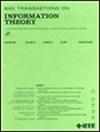Coset Constructions of Constant Dimension Codes by Cosets of Optimal Ferrers Diagrams Rank Metric Codes
IF 2.9
3区 计算机科学
Q3 COMPUTER SCIENCE, INFORMATION SYSTEMS
引用次数: 0
Abstract
Constant dimension codes (CDCs) have received a lot of attention due to their application in random network coding. One main problem with CDCs is to improve the lower bound of用最优ferers图秩度量码的协集构造常维码的协集
恒定维码由于在随机网络编码中的应用而受到了广泛的关注。cdc的一个主要问题是对给定参数$n,d$和k改进$A_{q}(n,d,k)$的下界,其中$A_{q}(n,d,k)$表示所有$(n,M,d,k)_{q}$ cdc的最大大小。本文旨在将共集和联动构建相结合来构建cdc。确切地说,我们首先以不同的方式将协集和联动结构结合起来,然后将注意力转向协集结构。为了扩大由协集构造的cdc的规模,我们致力于通过${\mathcal {G}}_{q}(n, k)$中最优ferers图等级度量码的协集和并行性来构造尺寸尽可能大的具有固定距离的cdc列表。作为应用程序,获得了许多比以前最知名的代码更大的cdc,包括$13\leq n\leq 16$的$A_{q}(18, 6,9), A_{q}(14, 6, 7), ~A_{q}(12, 4, 6), A_{q}(10, 4, 5),A_{q}(14, 4, 7),$$A_{q}(16, 4, 8)$和$A_{q}(n, 4,4)$。
本文章由计算机程序翻译,如有差异,请以英文原文为准。
求助全文
约1分钟内获得全文
求助全文
来源期刊

IEEE Transactions on Information Theory
工程技术-工程:电子与电气
CiteScore
5.70
自引率
20.00%
发文量
514
审稿时长
12 months
期刊介绍:
The IEEE Transactions on Information Theory is a journal that publishes theoretical and experimental papers concerned with the transmission, processing, and utilization of information. The boundaries of acceptable subject matter are intentionally not sharply delimited. Rather, it is hoped that as the focus of research activity changes, a flexible policy will permit this Transactions to follow suit. Current appropriate topics are best reflected by recent Tables of Contents; they are summarized in the titles of editorial areas that appear on the inside front cover.
 求助内容:
求助内容: 应助结果提醒方式:
应助结果提醒方式:


